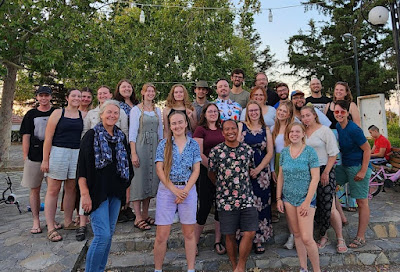The third fully fledged field work season of the Central Achaia Phtiotis Survey (CAPS) ran from July 14th to August 20th 2023. All of us were excited to welcome back staff, previous students as volunteers, and new students as part of the field school!
The CAPS 2023 Team. Unfortunately, Sophia Karapanou is missing in this picture
The CAPS project is co-run by Sophia Karapanou from the Ephorate of Antiquities in Larissa (Thessaly) and Margriet Haagsma from the University of Alberta. The project is supported by SSHRC and the Faculty of Arts of the University of Alberta, and we would like to thank the Hellenic Ministry of Culture, the Canadian Institute in Greece, the Municipality of Pharsala, and the town and people of Narthaki for their support and generosity. Special thanks goes to Pharsala’s mayor, Makis Eskioglou, who supported the renovation of the school where the students are staying and the acquisition of new mattresses and beds. Our project would be nowhere without the help and support of village proedros Thanasis Lelentzis and the ever-charming hospitality of Elias Papadopoulos and his family.
CAPS is focused on landscape use over time and we ask how different groups of people have interacted with this region, and how the human presence has resulted in anthropogenic change in the landscape. In addition to our own research questions, our work has now seen the added challenge that many agricultural fields have been designated for the construction of solar panels, in many cases in areas of archaeological significance. This has resulted in a complex situation, where we are just one stakeholder in the relationship between local landowners, energy companies, and the Greek archaeological service. Over the past years, and thanks to our work, various fields have been excluded from solar panel construction, as our role has been to prioritise and record the presence of archaeologically significant material in these areas. Yet, throughout the season we saw evidence of construction beginning in many areas we were working in.
As part of the project, CAPS has focused on scanning the shrub covered areas using LiDAR technology. Yet, the majority of our time is spent on pedestrian survey. Prior to this year, our team had covered around 430 hectares of cultivated and uncultivated land. This year, our team consisted of six staff, five volunteers, and 15 field school students from the University of Alberta. Over the course of the five weeks, we were able to survey approximately 150 hectares, and documented a looted tholos tomb (tholos 14), an ottoman fountain house, and a Hellenistic structure all located east of the Kastro.
While many fields (and their subdivided “tracts”) yielded little to no material, the team did discover areas where the increased density of finds point to areas of human activity. The majority of these areas could be dated to the Classical/Hellenistic, Late Roman, Byzantine, and Ottoman periods, and most finds indicate activities of an agrarian character, such as storage jars and grinding stones. Of particular interest is an area called Paleochori, which staff and students spend the better part of two weeks surveying. While most of the region did not result in a lot of material, a large field contained a significant amount of Byzantine material. At the northern end of this field, the remains of a small walled citadel were found with material of Archaic/Classical date.
A second area of interest is a fortified so-called ‘magoula’ in the area known as Arabises, near Aghios Antonios which was identified in our 2019 survey. From the magoula alone, 52 kg of material was recovered, mostly of Classical/Hellenistic, but also EIA and Ottoman dates. The remains of a village of Ottoman date were found in the last week of the survey. From the data collected during the 2023 season (including the regions with little material), we are able to get closer to answering our overarching research questions.
In addition to the systematic survey, our team also ground truthed areas of interest. This team cleaned the architecture for documentation. Of special note is a structure of Hellenistic date located on the eastern side of the hill of Kastro Kallithea.
Aerial photograph of the structure of Hellenistic date east of the Kastro
However, interpretations are currently varied as the structure does not appear defensive in nature and other interpretations suggest a monument serving a different purpose. Other activities in 2023 included flying our drone over a number of areas of human activity with architecture (including those cleaned by the ground truthing team!), allowing us to make detailed digital surface models of the areas.
Our field school students were extremely lucky to have an excellent team of instructors (if we do say so ourselves). Myles Chykerda was responsible for the GIS and setting out tracts with the GNSS and also provided a module for the students on GIS. The intensive survey was run by Ed Middleton and Magie Aiken who taught the basics of field walking and documentation. The apothiki was run by Adam Wiznura who taught students how to classify and date the finds and ran discussion groups. Margriet Haagsma orchestrated the entire project and still found time to teach the students modules on artefact drawing and LiDAR. In addition to the field school, Gino Canlas ran a ground truthing team composed of volunteers.
Beyond our archaeological work, staff, students, and volunteers had the opportunity to visit archaeological sites and museums (including the Kastro Kallithea exhibit in Farsala!), visit the local winery in Narthaki, attend the annual pazari, and enjoy the summer in Greece.
On site in Pharsala: grad students Josh Passey and Matthew Spinks presenting on the battles of Kynoskephalai (197 BCE) and Pharsalos (48 BCE)
Magie Aiken, Margriet Haagsma & Ed Middleton, CAPS






No comments:
Post a Comment